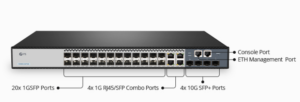Situatie
Check the model number of your shiny new switch. Or, if you are using a spare, check the device hardware and its connected cables for any damages. If everything checks out, power on the switch and verify that all the indicator lights are in working order. Next, use a rollover cable to console into the switch from your computer. To do this, you will need to download and install Putty (or a similar, fun-named software tool). Run Putty and select the 9600 speed serial connection.
Solutie
Pasi de urmat
Set up management IP
Unlike with that punny name you gave your home Wi-Fi network, when setting up the hostname for your switch you should probably stick to a more professional and standard naming convention. Follow any preset naming assignment your company is using and then assign an IP address on the management VLAN. Next, make sure your switch has a set hostname and domain name.
Check VTP revision number
Hit the show vtp status command to reveal your Virtual Trunking Protocol (VTP) revision numbers. The VTP revision numbers determine which updates are to be used in a VTP domain. When you set a VTP domain name, the revision number is set to zero—after which each change to the VLAN database increases the revision number by one. Your switch will only process data from a neighboring switch coming from the same domain and if the revision number of the neighboring switch is higher than its own. This means that the switches will update their VLAN configuration based on the VTP information being sent by the switch with the highest revision number.
So, before you add your switch to the network, you’re going to want to set its revision number to zero. To easily reset the domain back to zero, change the config mode to transparent.
Configure access ports
You might already have a template ready for access port configuration, but in case you don’t, here are some commands you should use:
Configure trunk ports
Enter the command sh int g0/1 capabilities and check the trunking protocol supported. If ISL is supported, you have to issue the switchport trunk encapsulation dot1q on the trunk port configuration. If not, simply type switchport mode trunk. It means there is no other encapsulation supported so there is no need for an encapsulation command. It only supports 802.1Q.
Configure access ports
After already performing basic network switch configurations, it’s time to generate RSA keys to be used during the SSH process, using the crypto commands shown here:
Choose the size of the key modulus in the range of 360 to 2048 for your General Purpose Keys. Choosing a key modulus greater than 512 may take a few minutes.
Set up VTY line config
If you have not set the console line yet, you can easily input these values:
Set the enable password using the enable secret password command. Then, set the privilege exec password with username name privilege 15 secret password. Make sure that the password-encryption service is activated. Verify SSH access by typing ‘sh ip ssh’ to confirm that the SSH is enabled. You can now try to log in from a remote machine to verify that you can ssh to your Cisco switch.


Leave A Comment?